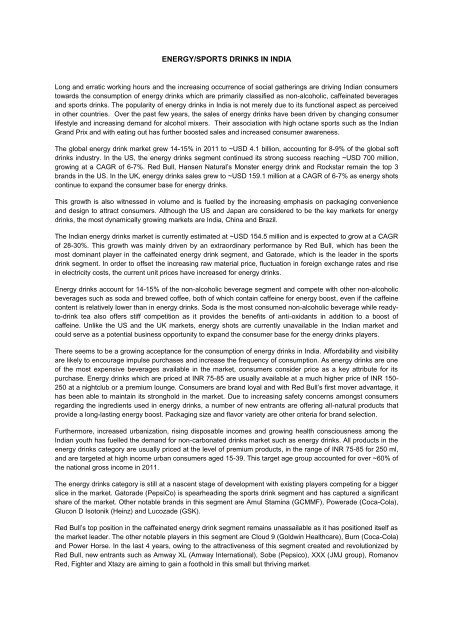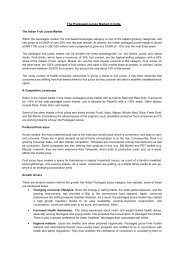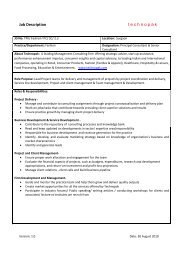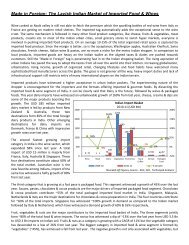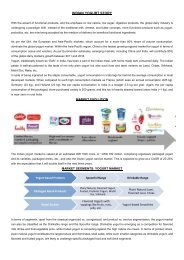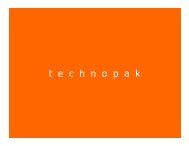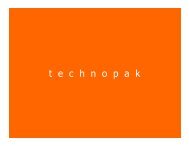ENERGY/SPORTS DRINKS IN INDIA - Technopak
ENERGY/SPORTS DRINKS IN INDIA - Technopak
ENERGY/SPORTS DRINKS IN INDIA - Technopak
You also want an ePaper? Increase the reach of your titles
YUMPU automatically turns print PDFs into web optimized ePapers that Google loves.
<strong>ENERGY</strong>/<strong>SPORTS</strong> <strong>DR<strong>IN</strong>KS</strong> <strong>IN</strong> <strong>IN</strong>DIA<br />
Long and erratic working hours and the increasing occurrence of social gatherings are driving Indian consumers<br />
towards the consumption of energy drinks which are primarily classified as non-alcoholic, caffeinated beverages<br />
and sports drinks. The popularity of energy drinks in India is not merely due to its functional aspect as perceived<br />
in other countries. Over the past few years, the sales of energy drinks have been driven by changing consumer<br />
lifestyle and increasing demand for alcohol mixers. Their association with high octane sports such as the Indian<br />
Grand Prix and with eating out has further boosted sales and increased consumer awareness.<br />
The global energy drink market grew 14-15% in 2011 to ~USD 4.1 billion, accounting for 8-9% of the global soft<br />
drinks industry. In the US, the energy drinks segment continued its strong success reaching ~USD 700 million,<br />
growing at a CAGR of 6-7%. Red Bull, Hansen Natural’s Monster energy drink and Rockstar remain the top 3<br />
brands in the US. In the UK, energy drinks sales grew to ~USD 159.1 million at a CAGR of 6-7% as energy shots<br />
continue to expand the consumer base for energy drinks.<br />
This growth is also witnessed in volume and is fuelled by the increasing emphasis on packaging convenience<br />
and design to attract consumers. Although the US and Japan are considered to be the key markets for energy<br />
drinks, the most dynamically growing markets are India, China and Brazil.<br />
The Indian energy drinks market is currently estimated at ~USD 154.5 million and is expected to grow at a CAGR<br />
of 28-30%. This growth was mainly driven by an extraordinary performance by Red Bull, which has been the<br />
most dominant player in the caffeinated energy drink segment, and Gatorade, which is the leader in the sports<br />
drink segment. In order to offset the increasing raw material price, fluctuation in foreign exchange rates and rise<br />
in electricity costs, the current unit prices have increased for energy drinks.<br />
Energy drinks account for 14-15% of the non-alcoholic beverage segment and compete with other non-alcoholic<br />
beverages such as soda and brewed coffee, both of which contain caffeine for energy boost, even if the caffeine<br />
content is relatively lower than in energy drinks. Soda is the most consumed non-alcoholic beverage while readyto-drink<br />
tea also offers stiff competition as it provides the benefits of anti-oxidants in addition to a boost of<br />
caffeine. Unlike the US and the UK markets, energy shots are currently unavailable in the Indian market and<br />
could serve as a potential business opportunity to expand the consumer base for the energy drinks players.<br />
There seems to be a growing acceptance for the consumption of energy drinks in India. Affordability and visibility<br />
are likely to encourage impulse purchases and increase the frequency of consumption. As energy drinks are one<br />
of the most expensive beverages available in the market, consumers consider price as a key attribute for its<br />
purchase. Energy drinks which are priced at <strong>IN</strong>R 75-85 are usually available at a much higher price of <strong>IN</strong>R 150-<br />
250 at a nightclub or a premium lounge. Consumers are brand loyal and with Red Bull’s first mover advantage, it<br />
has been able to maintain its stronghold in the market. Due to increasing safety concerns amongst consumers<br />
regarding the ingredients used in energy drinks, a number of new entrants are offering all-natural products that<br />
provide a long-lasting energy boost. Packaging size and flavor variety are other criteria for brand selection.<br />
Furthermore, increased urbanization, rising disposable incomes and growing health consciousness among the<br />
Indian youth has fuelled the demand for non-carbonated drinks market such as energy drinks. All products in the<br />
energy drinks category are usually priced at the level of premium products, in the range of <strong>IN</strong>R 75-85 for 250 ml,<br />
and are targeted at high income urban consumers aged 15-39. This target age group accounted for over ~60% of<br />
the national gross income in 2011.<br />
The energy drinks category is still at a nascent stage of development with existing players competing for a bigger<br />
slice in the market. Gatorade (PepsiCo) is spearheading the sports drink segment and has captured a significant<br />
share of the market. Other notable brands in this segment are Amul Stamina (GCMMF), Powerade (Coca-Cola),<br />
Glucon D Isotonik (Heinz) and Lucozade (GSK).<br />
Red Bull’s top position in the caffeinated energy drink segment remains unassailable as it has positioned itself as<br />
the market leader. The other notable players in this segment are Cloud 9 (Goldwin Healthcare), Burn (Coca-Cola)<br />
and Power Horse. In the last 4 years, owing to the attractiveness of this segment created and revolutionized by<br />
Red Bull, new entrants such as Amway XL (Amway International), Sobe (Pepsico), XXX (JMJ group), Romanov<br />
Red, Fighter and Xtazy are aiming to gain a foothold in this small but thriving market.
NourishCo, a joint venture between PepsiCo India and Tata Global Beverages, has plans for a national rollout of<br />
its first fully-developed energy drink, Lehar Gluco Plus. Red Bull’s global competitor Monster has also initiated<br />
talks for a potential entry into the Indian market with Rahul Narang Group (RNG) as its distribution partner. Prior<br />
to 2008, Rahul Narang Group (RNG) was selling and importing Red Bull in India on its own. Most of the energy<br />
drink products are imported with the exception of Cloud 9 which is manufactured in India.<br />
Red Bull, with its first mover advantage and its unique product, is a brand built on marketing. The company<br />
spends 20-30% of its annual turnover on all sorts of regular and extreme sports, entertainment and events<br />
around the world. On the other hand, the JMJ group has engaged Bollywood star Shah Rukh Khan as its brand<br />
ambassador and has also entered into an agreement with Amalgamated Bean Coffee to promote its brands at all<br />
Café Coffee Day outlets across the country. Energy drinks manufacturers are continuously taking up new<br />
initiatives to connect with their young target audience and create awareness beyond the major cities in India.<br />
Companies are effectively trying to communicate with their target audience through promotions at nightclubs and<br />
parties and are taking concrete measures to avoid being compared to other soft drinks products in terms of unit<br />
price. Energy drinks manufacturers are using both above and below the line advertisements to enhance their<br />
market share. Coca-Cola, manufacturers of Burn, and Red Bull are entering into exclusive associations with<br />
fashion and music events for sponsorship and product sampling to attract consumer attention.<br />
With some recent deaths being preliminary linked to the consumption of energy drinks in the US, the Indian<br />
government is stepping up to ensure strict regulations in that industry. In June 2012, the Food Safety and<br />
Standards Authority of India (FSSAI) announced the mandatory use of statutory safety warnings and that all<br />
energy drinks should be renamed as “caffeinated beverages”. This impending change in regulations is expected<br />
to cause a short term ripple effect on India’s energy drinks market. Nevertheless, any long term effect on the<br />
major players in the country is ruled out as energy drinks are considered as a lifestyle choice. Although there is<br />
no confirmation on the upper limit of caffeine content in the energy drinks, the permissible limit in carbonated<br />
beverages is set at 145 parts per million, or ppm. Based on these figures, Red Bull and Burn seem to surpass the<br />
upper limit. This regulation may force the industry players to consider modifications in the formulation for their<br />
products and could also allow potential entrants into the market.<br />
The energy drinks segment is more of an urban phenomenon limited to the metros and mini metros. The<br />
distribution largely takes place through organized channels which is relatively easy. However, bagging a place for<br />
their product on retail shelves, vis-à-vis popular brands, can be challenging for the new entrants. The fate of the<br />
industry relies on a single brand that controls the majority of the market. Nevertheless, there is scope for a new<br />
entrant given the huge potential in the market. Setting up a manufacturing plant requires a moderate investment<br />
which could range between USD 7.3 and 10.9 million. The biggest challenge for this segment will be to ensure<br />
that its distribution system is flexible enough to cater to spikes in demand and encourage consumption through<br />
marketing while adhering to regulatory measures relating to permissible levels of caffeine content. As Indians are<br />
not too fond of extreme sports, energy drinks brands in India will need to find a niche of their own and market<br />
their products accordingly. Promotional strategies could be built around areas such as fashion, lifestyle and other<br />
consumption occasions to boost sales. Overall, the energy drinks market is an exciting segment that will continue<br />
to grow on the strength of innovations and changing lifestyle in India.<br />
Authored By:<br />
<strong>Technopak</strong> Food Team


